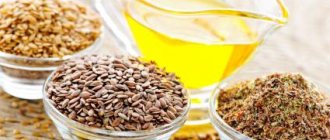A few hundred years ago, the physician Avicenna noted the healing properties of walnuts. They are rich in vitamins, minerals and healthy fatty acids. But how many calories do walnuts contain? What exactly are their benefits for the human body? Who are they shown to, and who should definitely refuse such a delicacy? We will consider the answers to these and many other questions below.
Nut varieties

Thanks to the efforts of breeders, there are at least 15 varieties that differ in frost and drought resistance, ripening time, and fruit size.
The most popular varieties are:
- Dessert is an early-ripening, drought-resistant variety, the best option for the southern regions.
- Elegant is an unpretentious, frost-resistant, unpretentious type of nut that can grow and bear fruit everywhere.
- Abundant - has an exquisite taste, is highly resistant to brown spot, but does not withstand severe frosts. Cultivated in regions characterized by high rainfall and a warm, humid climate.
- Fruitful - winter-hardy, abundantly fruiting variety, moderately resistant to brown spot. Can grow in all regions.
- Aurora is a variety that is resistant to frost and various diseases and is cultivated everywhere.
- Dawn of the East is one of the most frost-resistant and unpretentious types of walnut, characterized by early ripening, growing throughout the middle zone.
- Giant - distributed throughout Russia, has large fruits, the weight of which can reach 10 g.
- Ideal - popular in the northern regions of the country due to its incredible frost resistance and high yield. The tree prefers moderately moist, well-lit areas.
Calorie table
This table shows the calorie content of different types of walnuts per 100 grams and in 1 piece.
| Type of walnuts | Kcal per 100 g | Kcal in 1 piece |
| Raw | 654 | 32,7 |
| Fried | 680 | 27,2 |
| Greens | 600 | 30 |
The conclusion is simple: walnut kernels will be extremely beneficial if eaten correctly. It is important not to violate the daily norm and not to consume them on an empty stomach. It is best to replace an afternoon snack with this delicacy. And for whom walnuts are especially useful, you can find out from the video:
Chemical composition
Nutritionists recommend that you definitely include walnuts in your diet, since they contain all the elements necessary for the human body:
- vitamins (A, B-1,2,6,12, C, K, PP);
- amino acids (valine, glutamine, aspargine, cysteine);
- polyunsaturated fatty acids (folic, oleic, gallic, lanolin);
- micro- and macroelements (phosphorus, magnesium, potassium, sodium, zinc, manganese, iron).
Depending on the soil, variety, climate, presence or absence of proper care, the composition and percentage of certain substances may change.
The nutritional value
Table of vitamins:
| Vitamin name | Quantity per 100 g of product | |
| A | 8 mcg | |
| IN 1 | 0.4 mg | |
| AT 2 | 0.2 mg | |
| AT 3 | 4.8 mg | |
| AT 4 | 39.2 mg | |
| AT 5 | 0.8 mg | |
| AT 6 | 0.5 mg | |
| AT 9 | 98 mcg | |
| WITH | 6 mg | |
| E | 2.5 mg | |
| RR | 1.1 mg | |
| K1 | 2.6 mcg | |
Mineral content in the core:
| Name of mineral | Quantity | |
| Potassium | 665 mg | |
| Calcium | 122 mg | |
| Sodium | 3.1 mg | |
| Magnesium | 202 mg | |
| Phosphorus | 557 mg | |
| Iron | 2.5 mg | |
| Manganese | 2.0 mg | |
| Copper | 0.6 mg | |
| Fluorine | 0.8 mg | |
| Zinc | 2.6 mg | |
Calorie content and BZHU
Walnut is considered one of the most high-calorie foods. The energy value of 100 g of peeled kernels ranges (depending on the variety) from 630 to 670 kcal.
The composition of the BJU is as follows:
- proteins - 16.3-17.8g;
- carbohydrates - 11.2-16.04 g;
- fat - 60.3-71.9 g.
Of these, monounsaturated and polyunsaturated (healthy) fats account for approximately 55.2-65 g, and less than 5 g remain for saturated (harmful) fats. The rest of the weight comes from water (about 4 g) and dietary fiber.
The calorie content of 1 walnut depends on its size, for example:
| Nut weight (g) | Calorie content (kcal) |
| 5 | 32 |
| 7-8 | 50 |
| 10 | 63 |
Calorie content
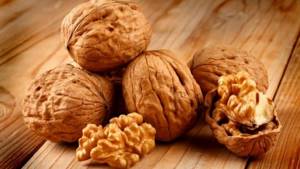
Calories in walnuts are a stumbling block that haunts people who are watching their waistline and are afraid of gaining excess weight. On the one hand, they can be understood, because the number of kilocalories is indeed impressive. 100 grams of this delicacy contains 654 kcal. But this figure seems scary only at first glance. If you look in more detail, then for 100 grams of walnuts there are as many as 50 pieces of fruit. Even the most avid nut lover cannot eat such a quantity of fruits in a day.
Accordingly, the weight of one fruit is only 5 grams.
Doctors and nutritionists say that the daily requirement of walnuts, which can be safely consumed without harm to the figure, is 4-6 fruits. By observing this dose, you will get the maximum benefit from such a tasty and valuable delicacy.
To prove with facts the absolute safety of such a number of nuts for the figure, we will make detailed mathematical calculations and calculate the calorie content of several pieces of fruit.
If 100 grams contain 654 kcal, then, accordingly, 10 grams of nuts contain 65.4 kcal, and if one fruit contains only 5 grams, then its calorie content is approximately 33 kcal. Accordingly, eating 6 fruits a day, you get only 196 kcal. Such an amount will in no way provoke excess weight, so all concerns about your figure are absolutely groundless.
Benefits of walnuts
The unique composition of the walnut determines its beneficial properties as a remedy that can:
- have a beneficial effect on the gastrointestinal tract;
- increase the elasticity of blood vessels;
- normalize heart function;
- improve memory;
- raise the level of intellectual development.
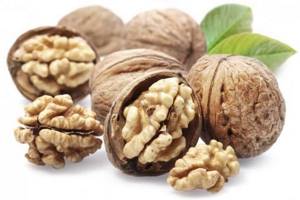
It contains substances that can:
- cleanse blood vessels from cholesterol;
- normalize insulin levels in diabetic patients;
- reduce the risk of heart disease;
- prevent the development of malignant tumors;
- prevent age-related vision deterioration;
- promote weight loss;
- improve the condition of skin, nails, hair.
Walnuts, which are high in calories, can be useful for people of different ages and both sexes.
For men
Eating nuts daily will make up for the lack of calcium, zinc and magnesium, which normalize the production of the male hormone testosterone, which stimulates the secretory activity of the gonads. This will help the stronger sex maintain masculine strength and libido for a long time.
The zinc contained in nuts has a positive effect on the formation of the gonads in adolescents, and in adult men it significantly reduces the risk of developing prostatitis, prostate adenoma, and impotence. Walnuts can increase sperm activity and fight certain types of male infertility.
https://youtu.be/NuEA2TZutmk
They are also recommended for older men who want to maintain an erection at the proper level.
Also, walnuts can help build muscle, since they are a powerful source of protein, vitamins that regulate the process of protein breakdown and synthesis of muscle tissue, and substances that will relieve the feeling of fatigue, help quickly restore strength after training, and fill the body with energy.
For women
Retinol (vitamin A) contained in walnuts can have a beneficial effect on the condition of hair, nails, and skin, eliminating wrinkles and sagging. Vitamins E, B6, C, being the strongest natural antioxidants, will slow down the aging of the body and help preserve female beauty for a long time.

Mono- and polyunsaturated fats, saturating the body with all necessary nutrients, eliminate overeating, promoting weight loss and maintaining a healthy weight.
Also components of walnuts:
- reduce the risk of developing breast cancer;
- protect the nervous system, helping a woman resist stress, nervous exhaustion, and depression;
- strengthen the female body’s immunity and resistance to various types of infectious diseases;
- prevent the development of varicose veins;
- will help restore blood loss after heavy menstruation;
- will reduce the likelihood of early menopause;
- normalize hormonal levels.
During pregnancy
A walnut (the calorie content of 1 nut is 32-63 kcal) for the expectant mother will become a source of folic acid (vitamin B9) - a substance that will ensure the normal course of pregnancy and several times reduce the risk of developing pathologies of the neural tube of the fetus, as well as the heart, blood vessels and genitourinary system. systems of the unborn child.

Ingredients of walnut:
- amino acids will regulate specific processes aimed at maintaining pregnancy and stimulating the proper development of the fetus;
- Omega-3 fatty acids normalize the functioning of the stomach and intestines, relieve constipation, heartburn, and increased gas production - unpleasant companions of pregnancy;
- the vitamin complex will strengthen the immunity of the expectant mother and her baby, normalize the production of hormones, and, playing the role of a natural antidepressant, will help cope with fatigue, depression, and insomnia;
- iron will raise hemoglobin levels and reduce the risk of developing iron deficiency anemia, a common problem in pregnant women;
- microelements will strengthen a woman’s spine and relieve lower back pain, which usually occurs towards the end of pregnancy due to high weight load. Phosphorus and calcium will satisfy the fetus’s need for these elements, which it needs to form the skeleton, and it will not “claim” the mother’s reserves. Magnesium will help remove excess fluid from the body and relieve swelling in late pregnancy;
- phytosterols will cleanse the blood of excess cholesterol and prevent negative changes in blood vessels and the heart caused by increased stress on them during pregnancy.
When breastfeeding
With reasonable consumption of walnuts, a nursing mother has a chance to make milk more nutritious and, at the same time, not harm her own figure.
Nuts will saturate breast milk with substances that the baby needs for growth and development:
- complex of vitamins;
- useful minerals;
- protein, which contains 2 dozen essential amino acids, which are the “building material” for all body systems;
- natural fatty acids.

Pediatricians advise nursing mothers to include this product in their diet if the child is not gaining weight well, has low hemoglobin, or suffers from constipation: all these problems can be solved by eating walnuts. Regular consumption of it is also beneficial for the woman herself, since it will strengthen her immunity, eliminate the development of anemia and help her forget about problems with the gastrointestinal tract, bad mood, migraines, and chronic fatigue.
For children
The product is contraindicated for children under 3 years of age, but older children can enjoy it.
Walnut will be a source for them:
- amino acids necessary for normal growth;
- carbohydrates that provide energy;
- microelements that will stimulate brain function, allowing the baby to develop intellectually faster;
- macroelements (in particular calcium and phosphorus), which will strengthen bone tissue;
- vitamin that supports immunity and protects the child from various infections.
Unlike other products containing all of the above substances, nuts contain no cholesterol and few carbohydrates. They are able to regulate fat metabolism and do not lead to the formation of subcutaneous fat, which means they can be consumed even by overweight children.

Walnut is needed:
- young athletes;
- little scholars;
- children who have had infectious diseases, suffer from anemia, and get tired quickly;
- adolescents during puberty.
Beneficial features
It’s definitely worth introducing a small amount of kernels into your diet - you can get a storehouse of useful elements in a small fruit! We’ll talk about how to eat nuts correctly below, but now let’s discuss why they’re so good?
- Get rid of vitamin deficiency;
- Removes toxins and waste;
- Reduce blood sugar levels;
- Strengthen the immune system;
- Increase hemoglobin levels;
- Helps prevent the development of heart and vascular diseases;
- Normalize the functioning of the gastrointestinal tract;
- Stimulates brain function and mental activity;
- Accelerate metabolic processes;
- Stabilize blood pressure levels;
- Has an antiseptic and anti-inflammatory effect;
- Improves potency and increases libido.
We also recommend: Plantain seeds
Are you convinced that it’s worth adding a handful of nuts to your diet? Let's talk about what standard the experts have set! The main thing is not to overdo it.
Harm and contraindications for use
Walnuts, which are very high in calories, can be dangerous if consumed in excess or if you consume stale, rancid fruits.
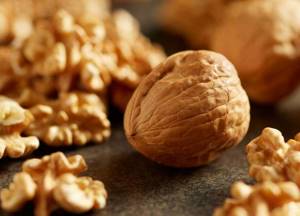
You should consume nuts with caution (or exclude them from your diet) if:
- large overweight, obesity (due to high calorie content);
- tendency to allergies (the nut contains substances that can cause an allergic reaction);
- under 3 years of age (it is difficult for a child’s stomach to cope with such an abundance of fats, in addition, the baby may choke on a nut);
- increased blood clotting (calcium contained in nuts can provoke the development of thrombosis in this pathology);
- inflammation of the pancreas, when you should avoid any fatty foods, including nuts;
- intestinal disorders (walnuts are a rather heavy food);
- skin diseases (even a small amount of nut can lead to an exacerbation of the disease).
Compound
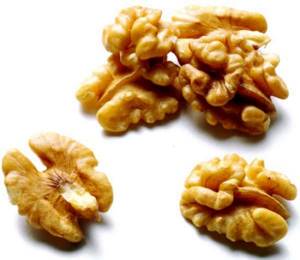
The composition of such a fruit is truly priceless. This is a real storehouse of vitamins and microelements.
The fruits contain beta-carotene, valuable for humans, and an abundance of microelements such as calcium and potassium, copper and selenium, iron and phosphorus, sodium and magnesium, etc.
The nut contains B vitamins, vitamin A, C, E, K, H, PP.
The fruit is rich in Omega-3 fatty acids, alkaloids and tannins.
It contains antioxidants and folic acid. By the way, there is 50 times more ascorbic acid in nuts than in the well-known lemons, oranges and tangerines.
The nut contains valuable vegetable protein, which is simply irreplaceable for vegetarians, people who fast, athletes, and people with active mental and physical activity.
Daily value of product
In order for walnuts to bring only benefits and not cause unpleasant effects, it is necessary to consume it only within reason, remembering the high calorie content of the product. The daily norm depends on several factors: gender, age, lifestyle, and the presence of any diseases.
For healthy men and women aged 17-45 years, whose activities are not associated with excessive physical exertion or intensive sports, the limit is:
| Floor | Daily norm (pcs.)* | At one time (pcs.)* |
| Women | 12 | 4 |
| Men weighing up to 80 kg | 21 | 7 |
| Men weighing more than 80 kg | 27 | 9 |
* means medium sized nut.
If the diet contains other types of nuts, seeds, halva, nut butter, the amount of nuts must be reduced. With a sports diet, the norms are different and are determined depending on the type of sport and the physical data of the athlete.
In addition, the maximum number of nuts:
- if you are overweight, you should limit it to 2-3 per day;
- after 45 it is recommended to reduce the daily intake by a third;
- older people over 60 should eat no more than 3 nuts per day;
- during pregnancy, the maximum daily intake is 5 pcs. per day, and if you are prone to allergies - 2;
- When breastfeeding, it is recommended to start consuming foods no earlier than the baby turns 2 months old; the maximum daily intake is 2 nuts. Subsequently, the norm can be increased, but the total amount of nuts should not exceed 30 g per day - this is quite enough to increase the calorie content of milk.
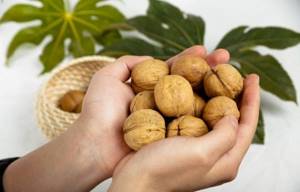
It is not recommended to give nuts to young children. It is advisable to introduce them into the diet no earlier than 3 years (some pediatricians believe that no earlier than 5 years), starting with ¼ of a nut. It must be crushed and added to any dish. Then you can gradually increase the norm, bringing it to 2-3 nuts (for children under 4 years old). Children 5-6 years old can, in the absence of contraindications, eat up to 4 nuts per day.
Features of nuts
In order for the kernels to bring exceptional benefits to the human body, you need to be able to use these products correctly. To do this, you need to know the number of kilocalories, as well as the level of proteins, fats and carbohydrates of each fruit. This will allow you not to exceed the permissible daily caloric intake, which is calculated individually. This is done based on the person’s age, gender and physical activity, as well as the presence of diseases or individual characteristics.
Congratulations!
Few people know that nuts are high-calorie, but very healthy foods. They are a natural source of vegetable proteins and fats. Therefore, for many people, such food becomes an excellent replacement for meat.
Nuts can reduce cholesterol or start the process of active metabolism. The main thing is not to exceed the recommended dosage. Otherwise, food can cause extra pounds. To avoid this, it is better to eat nuts, regardless of their type, only within reasonable limits. Knowing these properties, cooks began to add nuts to dishes such as:
- salads;
- cold snacks;
- hot;
- pates;
- desserts and sweets.
Despite the high energy value of nuts, they can also be found in a variety of modern diets. This happens thanks to the unique composition of the fruit, which contains minerals, vitamins and other beneficial macro- and microelements, as well as nutrients.
The use of nuts in dietetics and weight loss
If you eat nuts in reasonable doses, they will help you lose weight due to their following qualities:
- a unique composition that includes all the ingredients necessary for optimal metabolism;
- the ability to permanently eliminate the feeling of hunger due to plant fiber, which, swelling in the stomach, creates a feeling of fullness;
- in order to digest a walnut, you will need to spend quite a lot of energy: this means that the carbohydrates that enter the body will be used “for their intended purpose” and not replenish subcutaneous fat reserves;
- the components of nuts have the ability to reduce cholesterol levels, which are usually elevated in obese people, clear blood vessels of it and, due to this, restore normal blood flow, starting the processes of self-cleansing of the body and removing all excess;
- pinolenic acid contained in nuts stimulates the production of substances that block the feeling of hunger and relieve pathological appetite.

According to the medical journal Obesity, people who eat walnuts at least once every 2-3 days are less likely to accumulate excess weight.
Based on nuts, nutritionists have developed several types of nut diets, based on the ability of this product to fight excess appetite, replace animal fats with vegetable fats and activate metabolism, including the processes of breakdown of subcutaneous fat:
- A 3-day fruit and nut diet, which will ensure the loss of 2 kg of excess weight. Can be used monthly. Nuts are combined with fruits, fruit juices, vegetable salads;
- A 5-day nut diet will give the effect of 3-4 kg lost. You can repeat it once a month. Nuts are consumed together with kefir, fruit juice, boiled lean beef;
- A 10-day nut diet will ensure a loss of up to 5 kg, and will not require heroic efforts from those losing weight. Nuts are complemented with fruits, vegetable soups, and dairy products. It is possible to consume low-fat cottage cheese and eggs.
However, when using nuts for weight loss, you should remember their high nutritional value: 20 g of the product is enough for a snack, and 100 g is an alternative to a full 3-course meal.
Daily intake and rules of use
To maintain health, longevity and a beautiful figure, it is recommended to eat 7 walnuts every day. In order for them to be digested well, they must be chewed thoroughly.
Strengthening the body with walnuts
It is useful to use the following composition: mix one glass of chopped walnuts, raisins and dried apricots, add one lemon minced through a meat grinder and 300 g of honey. This delicacy should be eaten 1 tablespoon 3 times a day before meals. It has a general strengthening effect, strengthens the immune system and energizes.
Antiparasitic colon cleansing
To expel parasites from the body, it is recommended to consume walnuts for 3 days according to the following scheme:
- 6 nucleoli - in the morning half an hour before breakfast;
- 5 - before lunch;
- 4 - before dinner.
People were treated according to this scheme many centuries ago. The recipe remains relevant today, which confirms its effectiveness.
Healthy breakfast recipes for weight loss
Walnuts, which are too high in calories, are widely used in diets aimed at normalizing weight. However, it must be consumed in small quantities, preferably in the first half of the day, when the body needs energy.

To prepare a delicious dietary breakfast, you can combine nuts with raisins, dried apricots, honey, prunes, and add them to cereals, vegetable and fruit salads.
Fruit salad with nuts
To prepare the dish you will need:
- 2 bananas;
- 1 apple;
- 4 nuts.
Preparation:
- Cut the apple into slices or cubes.
- Mix the mixture with chopped nuts.
- Using a blender, make a sauce from bananas and pour it over apples and nuts.
Oatmeal with fruits and nuts
Ingredients you will need:
- oatmeal is a source of “slow” carbohydrates;
- fruits - fiber, which will create a feeling of fullness;
- nuts are vegetable protein.
Preparation:
- 2 tbsp. l. Boil oatmeal in water.
- Add 50 g of fruit and 1 tbsp to the container. l. crushed nuts.
- Mix everything well.
When is the best time to eat nuts?
If it is advisable to eat this tasty product separately from the rest or not combine it with heavy foods (vegetables instead of meat, no bread, etc.), doctors do not argue among themselves, then when is it better to eat nuts - in the morning or in the evening, from Each of them can obtain diametrically opposed information. It is recommended to leave high-calorie foods for the first half of the day, but at the same time it is better to drive away acute hunger before bed with a couple of nuts rather than candy.
A few tips for safe weight loss:
- Mix nuts with oatmeal during breakfast and you will forget about hunger for 3-4 hours.
- Try replacing your afternoon snack with a handful of almonds - you'll eat less for dinner.
- A few nuts in a green salad without dressing in the evening - not high in calories, but satisfying.
- You should not eat any nuts at night, even the low-calorie ones.

Pumpkin cocktail with walnuts.
The cocktail, which tastes like pumpkin pie, will help you lose weight, strengthen the immune system, and have a beneficial effect on your eyes and skin thanks to the vitamin A contained in pumpkin and the complex of amino acids found in walnuts.
Preparation:
- Add 2 tbsp to 350 g of water or natural yogurt. l. vanilla protein powder, 1 tbsp. l. crushed nuts, cinnamon, pureed pumpkin.
- Mix the mixture until the mixture has the consistency of sour cream.
- Beat everything with a blender.
Yogurt with nuts
This dish is a morning dish, but it needs to be prepared in the evening.

You will need:
- walnuts;
- natural yogurt;
- any fruit in any quantity.
Preparation:
- Mix yogurt with chopped nuts in a blender.
- Top the resulting mixture with fruit.
- Sprinkle the dish with coconut flakes and put it in the refrigerator until the morning.
Banana breakfast
Breakfast for those losing weight is prepared quickly, looks beautiful and relieves hunger for a long time.
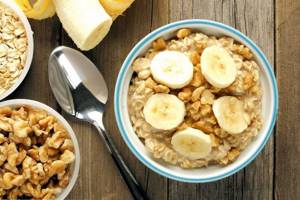
Preparation:
- Cut the banana into 2 halves and place on a plate.
- Lay out in layers - muesli mixed with chopped walnuts, low-fat cottage cheese, to which natural yogurt has been added (until a paste-like mass is obtained), honey.
The number of ingredients is arbitrary.
Millet with walnuts
A tasty and satisfying dish that will satisfy your hunger for a long time.
To prepare it you will need:
- prunes - ½ cup;
- walnuts - 2 tbsp. l.;
- millet - 1 tbsp.;
- water – 2 tbsp.;
- sugar, salt, butter (if desired).
Preparation:
- Chop the washed prunes and boil for 10 minutes.
- Pour millet into the mass, add salt, add sugar, and cook until tender.
- Put nuts (chopped or whole kernels) into the finished porridge, you can add butter.
How to properly store walnuts without shells
If nuts are prepared for future use for long-term storage, then it is advisable to leave them in the shell, which will increase their shelf life by up to a year. Shelled walnuts are more convenient to use, but will require special conditions so that all their valuable qualities do not disappear, and the fruit itself does not become moldy and begin to taste bitter.
The following storage options are possible for shelled nuts:
- At room temperature: Requires a dry, dark place. Nuts are stored in a tightly buried glass or metal container for no more than 2 weeks.
- In the refrigerator or dry cellar: place the nuts in an airtight container that is placed on a shelf (not on the door). Here they can lie for about six months.
- In the freezer: with blast freezing, the fruits are stored for a whole year. The appropriate freezer mode should be set in advance so that the temperature there has time to drop to the desired values. It is recommended to divide the nuts into portions, each of which is packed in an airtight container.
Thawed nuts must be consumed within 24 hours; they cannot be re-frozen.
The surface of peeled nuts purchased in a store may contain bacteria, dust, and other contaminants, so before storage they must be disinfected by rinsing thoroughly in warm water and calcining in a frying pan or oven (for an hour at low temperature to remove excess moisture).
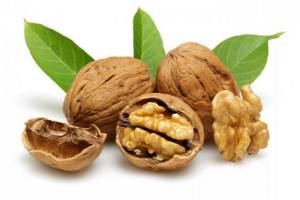
In the future, regardless of the chosen storage method, the product must be periodically checked, removing moldy, darkened or other signs of spoilage: they cannot be eaten, even after heat treatment. It is easier to deal with walnuts in the shell: they are placed in any container (linen bags, wooden boxes, glass jars) and stored in a dark, dry place for a year, periodically checking for mold.
Varieties
The varieties of such fruits are varied. Different varieties differ in different maturity periods, sizes, peel hardness and shelf life.
The most popular varieties are: “Giant” and “Ideal”. They take root and bear fruit best in our latitudes. But we also have other varieties:
- Elegant.
- English.
- Fruitful.
- Black.
- Dawn of the East.
- Aurora.
Use for various diseases
Medicines prepared from walnuts can be an effective and inexpensive alternative to pharmaceutical drugs.
For example, green walnut tinctures are used:
- for many diseases of the stomach and intestines;
- to eliminate problems of the genitourinary system;
- as prevention of cancer;
- as an adjuvant in the treatment of tuberculosis and leukemia;
- for vascular diseases.
Walnut jam is an excellent and tasty remedy for combating extra pounds, chronic fatigue caused by vitamin deficiency, stress, bad mood and insomnia. It can also improve performance and strengthen memory.
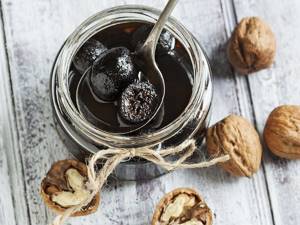
As for ripe walnuts, they are used everywhere in homeopathic medicine for the purpose of:
- alleviating the condition of patients with metabolic syndrome;
- prevention of cardiovascular diseases;
- normalization of pressure in hypertension;
- for anemia, as a means of increasing hemoglobin levels;
- to combat helminths;
- as a harmless remedy for constipation, dysbacteriosis, and digestive problems;
- in the treatment of impotence in men;
- as a prevention of obesity.
The list is not complete, but it is enough to evaluate the capabilities of the walnut, which can become an exquisite high-calorie delicacy, a medicine, and a means of preserving youth, beauty and health for a long time.
Use of nut
Walnut is a “waste-free” plant. All parts of the tree are used productively: fruits, bark, roots, leaves. The shells are used to make environmentally friendly fuel for boilers, barbecues, and fireplaces - pellets. The foliage and shell are mixed into feed and fertilizers. Powder from nuts and shells is a natural brown dye that is added to oil and other types of paints.
In the production of cosmetics, walnuts are an important ingredient. Its properties are used in medicinal and caring cosmetics to eliminate skin problems; the processed nut and its oil are added to creams, tonics, masks, toothpastes, balms, and lipsticks. The aroma of nut extract is basic for many perfume compositions. Walnut wood is an excellent and sought-after material for furniture production.
Use in cooking
More often, walnuts are associated with delicious desserts: cakes, muffins, pastries, creams, mousses, chocolate products. Oriental sweets (halva, baklava, Turkish delight, nougat) cannot be prepared without nuts. Although in general its gastronomic role is much broader. The piquant taste of meat, poultry, and fish can be easily achieved by adding crushed kernels to the spices.
In salads and main courses, the nut can become an independent ingredient or part of a dressing or sauce. Walnuts are easy to turn into fillings, breadings, and seasonings. Non-alcoholic and alcoholic drinks are made from the kernels. In southern countries, jam is made from unripe fruits and marinades are made for preparations.
In medicine and pharmacology
Medical treatises with a centuries-old history tell about the use of walnuts. They indicate the hemostatic effect of the plant, anti-inflammatory, and adsorbent. In the modern pharmaceutical industry, all parts of the walnut tree are used to produce astringents, bactericidal, tonic and antiparasitic agents. Walnut is included in the pharmacopoeias of different countries - a strictly established standard of rules for the production and testing of medicines.
There are herbal preparations with walnut extract for anti-tuberculosis therapy. Walnut kernel oil is used to treat and restore skin after burns. Russian pharmacologists have patented an ointment that contains an extract of green nut fruits with pericarp and tree leaves. It is intended for the treatment of mastopathy.
Traditional medicine is replete with recipes based on walnuts made from peels, kernels, partitions, and shells. Alcohol tinctures and decoctions, according to the “healers,” are supposed to cure all diseases. Please note that such recommendations are unproven and subjective, and the consequences of such treatment are unpredictable.
Properties of nuts for weight loss
70% of walnuts consist of fats, which, it would seem, automatically makes the product far from dietary. And it has enough calories. How then can we explain that walnuts have been an integral part of the ascetic diet of yogis for hundreds of years? The answer lies in one of the latest experiments by researchers from San Diego. Almost 300 women from 25 to 72 years old took part in it. You can view the experiment here.
All ladies received clear nutritional instructions: reduce the total caloric intake of the diet by 500-700 kcal and the amount of carbohydrates in it. Group No. 1 lost weight by eating walnuts (40 g per day), group No. 2 did not include them in the menu. As a result, the “nut” group lost 10% of weight, the other only 5%. The organizers made conclusions. Participants in the first group ate less overall because they felt fuller longer after eating a small portion of nuts. That's the whole secret of losing weight. In addition, vegetable protein was easily digestible, and fiber stimulated the gastrointestinal tract.
Advice. Don't like porridge without butter, but are on a diet? Replace the oil with a couple of walnut kernels. This dish will delight you with taste and will be much healthier.









